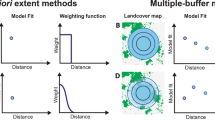Abstract
Geographical information systems (GIS) are well suited to the spatial analysis of landscape data, but generally lack programs for calculating traditional measures of landscape structure (e.g., fractal dimension). Standalone programs for calculating landscape structure measures do exist, but these programs do not enable the user to take advantage of GIS facilities for manipulating and analyzing landscape data. Moreover, these programs lack capabilities for analysis with sampling areas of different size (multiscale analysis) and also lack some needed measures of landscape structure (e.g., texture).
We have developed the r.le programs for analyzing landscape structure using the GRASS GIS. The programs can be used to calculate over sixty measures of landscape structure (e.g., distance, size, shape, fractal dimension, perimeters, diversity, texture, juxtaposition, edges) within sampling areas of several sizes simultaneously. Also possible are moving window analyses, which enable the production of new maps of the landscape structure within windows of a particular size. These new maps can then be used in other analyses with the GIS.
Similar content being viewed by others
References
Addicott, J.F., Aho, J.M., Antolin, M.F., Padilla, M.F., Richardson, J.S. and Soluk, D.A. 1987. Ecological neighborhoods: scaling environmental patterns. Oikos 49: 340–346.
Austin, R.F. 1984. Measuring and comparing two-dimensional shapes. In Spatial Statistics and Models. pp. 293–312. Edited by G.L. Gaile and C.J. Willmott. D. Reidel Publ. Co., Boston.
Baker, W.L., Egbert, S.L. and Frazier, G.F. 1991. A spatial model for studying the effects of climatic change on the structure of landscapes subject to large disturbances. Ecol. Modell. 56: 109–125.
Berry, J.K. 1987. Computer-assisted map analysis: potential and pitfalls. Photogr. Engin. and Rem. Sen. 53: 1405–1410.
Cowen, D.J. 1988. GIS versus CAD versus DBMS: what are the differences? Photogr. Engin. and Rem. Sen. 54: 1551–1555.
Dixon, C. and Leach, B. 1978. Sampling methods for geographical research. Geo Abstracts, Norwich. 47. pp.
Donovan, M.L., Rabe, D.L. and Olson, C.E. Jr. 1987. Use of geographic information systems to develop habitat suitability models. Wild. Soc. Bull. 15: 574–579.
Forman, R.T. and Godron, M. 1986. Landscape Ecology. John Wiley and Sons, New York. 619. pp.
Gardner, R.H., Milne, B.T., Turner, M.G. and O'Neill, R.V. 1987. Neutral models for the analysis of broad-scale landscape pattern. Landsc. Ecol. 1: 19–28.
Goward, S.N., Tucker, C.J. and Dye, D.G. 1985. North American vegetation patterns observed with the NOAA-7 Advanced Very High Resolution Radiometer. Vegetatio 64: 3–14.
Griffiths, G.H. and Wooding, M.G. 1988. Pattern analysis and the ecological interpretation of satellite imagery. Proc. of IGARSS '88 Symposium. 88: 13–16.
Haralick, R.M. 1975. Statistical and structural approaches to texture. Proceedings of the IEEE 67: 786–804.
Haralick, R.M., Shanmugam, K. and Dinstein, I. 1973. Textural features for image classification. IEEE Transactions on Systems, Man, and Cybernetics SMC-3: 610–621.
Harlow, C. 1989. The future of GIS's - 18 important trends. Tech. Papers of the 1989 ASPRS/ACSM Ann. Conv. Vol. 5: 16–25.
Haslett, J.R. 1990. Geographic information systems: a new approach to habitat definition and the study of distributions. TREE 5: 214–218.
Heinen, J. and Cross, G.H. 1983. An approach to measure interspersion, juxtaposition, and spatial diversity from covertype maps. Wildlife Soc. Bull. 11: 232–237.
Hodgson, M.E., Jensen, J.R., Mackey, H.E. Jr. and Coulter, M.C. 1988. Monitoring wood stork foraging habitat using remote sensing and geographic information systems. Photogr. Engin. and Rem. Sen. 54: 61–68.
Hunsaker, C.T., Carpenter, D.E. and Messer, J. 1990. Ecological indicators for regional monitoring. Bull. Ecol. Soc. Am. 71: 165–172.
Johnson, L.B. 1990. Analyzing spatial and temporal phenomena using geographical information systems: a review of ecological applications. Landsc. Ecol. 4: 31–43.
Johnston, C.A. and Naiman, R.J. 1990. The use of a geographic information system to analyze long-term landscape alteration by beaver. Landsc. Ecol. 5: 5–19.
Krummel, J.R., Gardner, R.H., Sugihara, G., O'Neill, R.V. and Coleman, P.R. 1987. Landscape patterns in a disturbed environment. Oikos 48: 321–324.
Mead, R.A., Sharik, T.L., Prisley, S.P. and Heinen, J.T. 1981. A computerized spatial analysis system for assessing wildlife habitat from vegetation maps. Can. J. Rem. Sens. 7: 34–40.
Musick, H.B. and Grover, H.D. 1990. Image textural measures as indices of landscape pattern. In Quantitative Methods in Landscape Ecology. pp. 77–103. Edited by M.G. Turner and R.H. Gardner. Springer-Verlag, New York.
O'Neill, R.V., Krummel, J.R., Gardner, R.H., Sugihara, G., Jackson, B., Angelis, D.L., Milne, B.T., Turner, M.G., Zygmunt, B., Christensen, S.W., Dale, V.H. and Graham, R.L. 1988. Indices of landscape pattern. Landsc. Ecol. 1: 153–162.
Piwowar, J.M., LeDrew, E.F. and Dudycha, D.J. 1990. Integration of spatial data in vector and raster formats in a geographic information system environment. Int. J. Geogr. Inform. Syst. 4: 429–444.
Tomlin, C.D. 1990. Geographic information systems and cartographic modeling. Prentice Hall, Englewood Cliffs, NJ. 249. pp.
Turner, M.G. 1990. Spatial and temporal analysis of landscape patterns. Landsc. Ecol. 4: 21–30.
Turner, M.G., O'Neill, R.V., Gardner, R.H. and Milne, B.T. 1989. Effects of changing spatial scale on the analysis of landscape pattern. Landsc. Ecol. 3: 153–162.
USA-CERL. 1991. GRASS 4.0 User's Manual. United States Army Corps of Engineers Construction Engineering Research Laboratory, Champaign, Ill.
Wiens, J.A. 1989. Spatial scaling in ecology. Functional Ecol. 3: 385–397.
Author information
Authors and Affiliations
Rights and permissions
About this article
Cite this article
Baker, W.L., Cai, Y. The r.le programs for multiscale analysis of landscape structure using the GRASS geographical information system. Landscape Ecol 7, 291–302 (1992). https://doi.org/10.1007/BF00131258
Issue Date:
DOI: https://doi.org/10.1007/BF00131258




